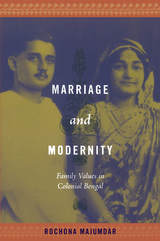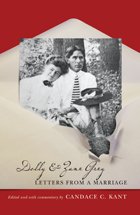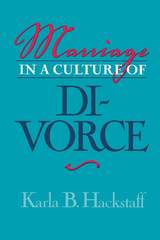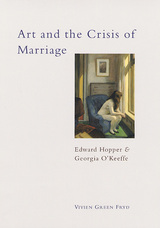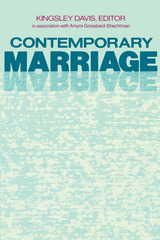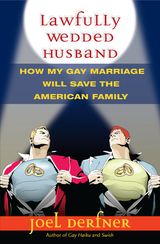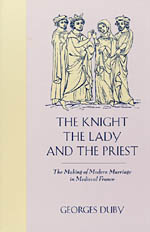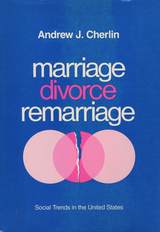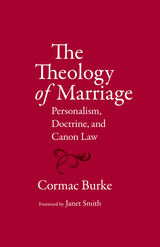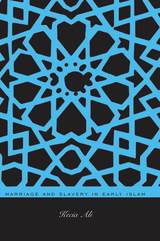MarriageCollection by Cassandra Verhaegen (10 items)Books to wed yourself to. Includes the following tags:
1872-1939, African American families, American Family, Artists, Architects, Photographers, Canon & Ecclesiastical Law, Christian Church, Congresses, Crisis, Cross-cultural studies, Demography, Divorce, Doctrines, Duby, Georges, Enlarged Edition, Equality, Gay authors, Gay men, Individual Artists, Islamic, Longitudinal studies, Marriage, Marriage & Family, Marriage (Canon law), Married people, Painters, Revised, Same-sex marriage
See More
|
Marriage and Modernity
by Rochona Majumdar
Duke University Press, 2009
An innovative cultural history of the evolution of modern marriage practices in Bengal, Marriage and Modernity challenges the assumption that arranged marriage is an antiquated practice. Rochona Majumdar demonstrates that in the late colonial period Bengali marriage practices underwent changes that led to a valorization of the larger, intergenerational family as a revered, “ancient” social institution, with arranged marriage as the apotheosis of an “Indian” tradition. She meticulously documents the ways that these newly embraced “traditions”—the extended family and arranged marriage—entered into competition and conversation with other emerging forms of kinship such as the modern unit of the couple, with both models participating promiscuously in the new “marketplace” for marriages, where matrimonial advertisements in the print media and the payment of dowry played central roles. Majumdar argues that together the kinship structures newly asserted as distinctively Indian and the emergence of the marriage market constituted what was and still is modern about marriages in India. Majumdar examines three broad developments related to the modernity of arranged marriage: the growth of a marriage market, concomitant debates about consumption and vulgarity in the conduct of weddings, and the legal regulation of family property and marriages. Drawing on matrimonial advertisements, wedding invitations, poems, photographs, legal debates, and a vast periodical literature, she shows that the modernization of families does not necessarily imply a transition from extended kinship to nuclear family structures, or from matrimonial agreements negotiated between families to marriage contracts between individuals. Colonial Bengal tells a very different story.
1
|
Dolly and Zane Grey
edited by Candace C. Kant
University of Nevada Press, 2011
Popular western writer Zane Grey was a literary celebrity during his lifetime and the center of a huge enterprise based on his writing, which included books, magazine serials, film and stage versions of his stories, even comic strips. His wife, Dolly, closely guided Grey's career almost from its beginning, editing and sometimes revising his work, negotiating with publishers and movie studios, and skillfully managing the considerable fortune derived from these activities. Dolly maintained the facade of a conventional married life that was essential to Grey's public image and the traditional middle-class values his work reflected. This facade was constantly threatened by Grey's numerous affairs with other women. The stress of hiding these dalliances placed a huge strain on their relationship, and much of Zane and Dolly's union was sustained largely by correspondence. Their letters--thousands of them--reveal the true nature of this complex partnership. As edited by Candace Kant, the letters offer an engrossing portrait of an extremely unorthodox marriage and its times.
2
|
Marriage In A Culture Of Divorce
by Karla Hackstaff
Temple University Press, 1999
Today, when fifty percent of couples who marry eventually get divorced, it's clear that we have moved from a culture in which "marriage is forever" to one in which "marriage is contingent." Author Karla Hackstaff looks at intact marriages to examine the impact of new expectations in a culture of divorce. Marriage in a Culture of Divorce examines the shifting meanings of divorce and gender for two generations of middle-class, married couples. Hackstaff finds that new social and economic conditions both support and undermine the efforts of spouses to redefine the meaning of marriage in a culture of divorce. The definitions of marriage, divorce, and gender have changed for all, but more for the young than the old, and more for women than for men. While some spouses in both generations believe that marriage is for life and that men should dominate in marriage, the younger generation of spouses increasingly construct marriage as contingent rather than forever. Hackstaff presents this evidence in archival case studies of couples married in the 1950s, which she then contrasts with her own case studies of people married during the 1970s, finding evidence of a significant shift in who does the emotional work of maintaining the relationship. It is primarily the woman in the '50s couples who "monitors" the marriage, whereas in the '70s couples both husband and wife support a "marital work ethic," including couples therapy in some cases. The words and actions of the couples Hackstaff follows in depth - the '50s Stones, Dominicks, Hamptons, and McIntyres, and the '70s Turners, Clement-Leonettis, Greens, Kason-Morrises, and Nakatos -- reveal the changes and contradictory tendencies of married life in the U.S. There are traditional relationships characterized by male dominance, there are couples striving for gender equality, there are partners pulling together, and partners pulling apart. Those debating "family values" should not forget, Hackstaff contends, that there are costs associated with marriage culture as well as divorce culture, and they should view divorce as a transitional means for defining marriage in an egalitarian direction. She convincingly illustrates her controversial position, that although divorce has its cost to society, the divorce culture empowers wives and challenges the legacy of male dominance that previously set the conditions for marriage endurance.
3
|
Art and the Crisis of Marriage
by Vivien Green Fryd
University of Chicago Press, 2002
Between the two world wars, middle-class America experienced a "marriage crisis" that filled the pages of the popular press. Divorce rates were rising, birthrates falling, and women were entering the increasingly industrialized and urbanized workforce in larger numbers than ever before, while Victorian morals and manners began to break down in the wake of the first sexual revolution. Vivien Green Fryd argues that this crisis played a crucial role in the lives and works of two of America's most familiar and beloved artists, Georgia O'Keeffe (1887-1986) and Edward Hopper (1882-1967). Combining biographical study of their marriages with formal and iconographical analysis of their works, Fryd shows how both artists expressed the pleasures and perils of their relationships in their paintings. Hopper's many representations of Victorian homes in sunny, tranquil landscapes, for instance, take on new meanings when viewed in the context of the artist's own tumultuous marriage with Jo and the widespread middle-class fears that the new urban, multidwelling homes would contribute to the breakdown of the family. Fryd also persuasively interprets the many paintings of skulls and crosses that O'Keeffe produced in New Mexico as embodying themes of death and rebirth in response to her husband Alfred Stieglitz's long-term affair with Dorothy Norman. Art and the Crisis of Marriage provides both a penetrating reappraisal of the interconnections between Georgia O'Keeffe's and Edward Hopper's lives and works, as well as a vivid portrait of how new understandings of family, gender, and sexuality transformed American society between the wars in ways that continue to shape it today.
4
|
Contemporary Marriage
edited by Kingsley Davis
contributions by Amyra Grossbard-Shechtman and Amyra Grossbard-Shechtman Russell Sage Foundation, 1985
This fascinating symposium is based on an assumption that no longer seems to need justification: that the institution of marriage is today experiencing profound changes. But the nature of those changes—their causes and consequences—is very much in need of explication. The experts contributing to this volume bring a wide range of perspectives—sociological, anthropological, economic, historical, psychological, and legal—to the problem of marriage in modern society. Together these essays help illuminate a form of relationship that is both vulnerable and resilient, biological and social, a reflection of and an influence on other social institutions. Contemporary Marriage begins with an important assessment of the revolution in marital behavior since World War II, tracing trends in marriage age, cohabitation, divorce, and fertility. The focus here is primarily on the United States and on idustrial societies in general. Later chapters provide intriguing case studies of particular countries. There is a recurrent interest in the impact on marriage of modernization itself, but a number of essays probe influences other than industrial development, such as strong cultural and historical patterns or legislation and state control. Beliefs and expectations about marriage are explored, and human sexuality and gender roles are also considered as factors in the nature of marriage. Contemporary Marriage offers a rich spectrum of approaches to a problem of central importance. The volume will reward an equally broad spectrum of readers interested in the meaning and future of marriage in our society.
5
|
Lawfully Wedded Husband
by Joel Derfner
University of Wisconsin Press, 2013
When Joel Derfner's boyfriend proposed to him, there was nowhere in America the two could legally marry. That changed quickly, however, and before long the two were on what they expected to be a rollicking journey to married bliss. What they didn't realize was that, along the way, they would confront not just the dilemmas every couple faces on the way to the altar—what kind of ceremony would they have? what would they wear? did they have to invite Great Aunt Sophie?—but also questions about what a relationship can and can't do, the definition of marriage, and, ultimately, what makes a family.
See More
Add to the mix a reality show whose director forces them to keep signing and notarizing applications for a wedding license until the cameraman gets a shot she likes; a family marriage history that includes adulterers, arms smugglers, and poisoners; and discussions of civil rights, Sophocles, racism, grammar, and homemade Ouija boards—coupled with Derfner's gift for getting in his own way—and what results is a story not just of gay marriage and the American family but of what it means to be human.
6
|
The Knight, the Lady and the Priest
by Georges Duby
translated by Barbara Bray University of Chicago Press, 1993
This ambitious study sets out to discover what marriage meant in the daily lives of the nobles of the tenth, eleventh, and twelfth centuries. Through entertaining anecdotes, family dramas, and striking quotations, Duby succeeds in bringing his subjects to life, making us feel as if we understand the motives and conflicts of those who inhabited the distant past. "It is typical of Duby's modest spirit and his book-long concern with the ancient status of beleaguered wives that he ends his study with a plea: 'We must not forget the women. Much has already been said about them. But how much do we really know?' Not everything, certainly, but far more than we did before the author began these charmingly erudite investigations."—Ken Turan, Time "It is refreshing to find a historian who is always conscious that we simply do not know what or how people thought 1000 years ago. . . . Duby explains the complicated machinations of the medieval churchman and the paterfamilias in a scholarly but lively style."—Sarah Lawson, New Statesman "Duby has written an extraordinarily rich book—a panoramic view of medieval marriage and the relations between men and women, full of arresting insights and human detail. . . . It is the work of a master historian at the peak of his powers on a subject of central relevance, compulsive and essential reading."—P. Stafford, British History Georges Duby (1919-1996) was a member of the Académie française and for many years held the distinguished chair in medieval history at the Collège de France. His books include The Three Orders; The Age of Cathedrals; The Knight, the Lady, and the Priest; Love and Marriage in the Middle Ages; and History Continues, all published by the University of Chicago Press.
7
|
Marriage, Divorce, Remarriage
by Andrew J. Cherlin
Harvard University Press, 1992
With roller coaster changes in marriage and divorce rates apparently leveling off in the 1980s, Andrew Cherlin feels that the time is right for an overall assessment of marital trends. His graceful and informal book surveys and explains the latest research on marriage, divorce, and remarriage since World War II.
8
|
The Theology of Marriage
by Cormac Burke
Catholic University of America Press, 2015
Please fill in marketing copy
See More
9
|
Marriage and Slavery in Early Islam
by Kecia Ali
Harvard University Press, 2010
What did it mean to be a wife, woman, or slave in a society in which a land-owning woman was forbidden to lay with her male slave but the same slave might be allowed to take concubines? Jurists of the nascent Maliki, Hanafi, and Shafi‘i legal schools frequently compared marriage to purchase and divorce to manumission. Juggling scripture, precedent, and custom on one hand, and the requirements of logical consistency on the other, legal scholars engaged in vigorous debate. The emerging consensus demonstrated a self-perpetuating analogy between a husband’s status as master and a wife’s as slave, even as jurists insisted on the dignity of free women and, increasingly, the masculine rights of enslaved husbands.
10
|
| Click here to go to the beginning. | ||||||||||
